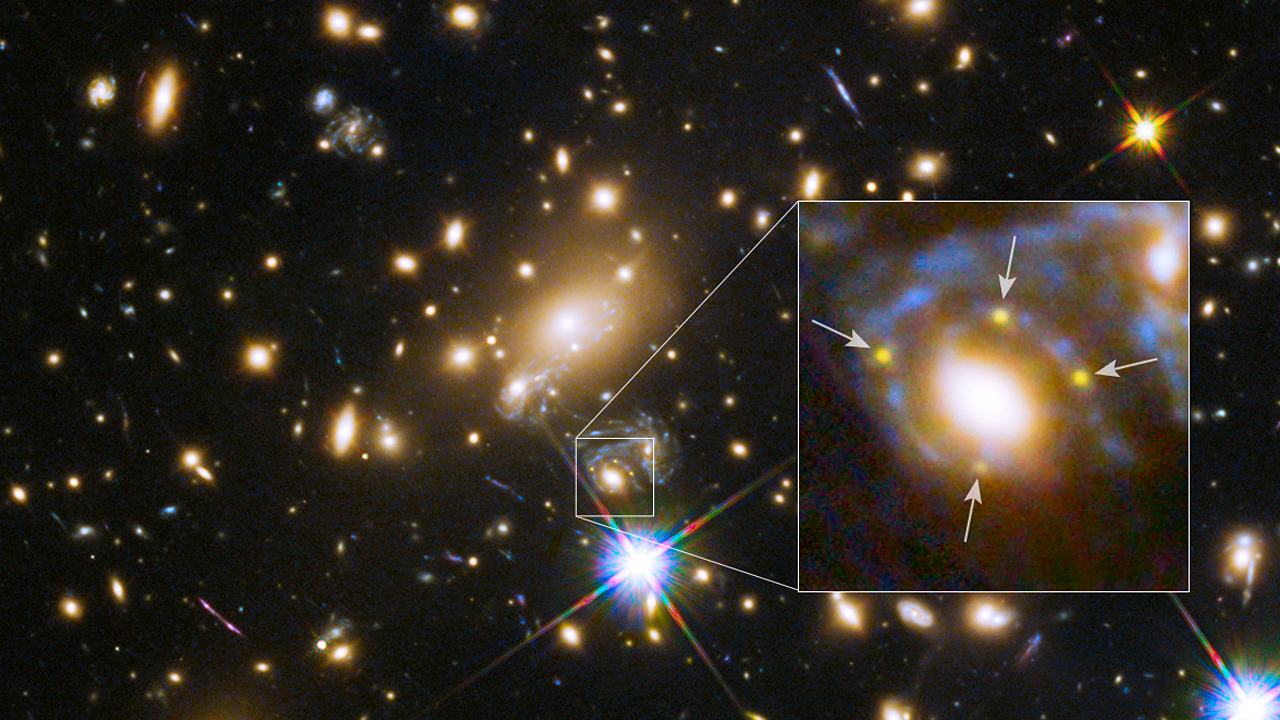First predicted supernova caught in the act. See it here
Meteorologist/Science Writer
Wednesday, December 16, 2015, 11:58 AM - The Hubble Space Telescope has just spied the very first light of the first predicted supernova, exactly where astronomers said it would show up.
This story was updated on June 2, 2016.
Back in November 2015, astronomers working with the Hubble Space Telescope announced that they were going to see a supernova sometime by early 2016. The video above shows a simulation of what they would have seen in 1995, had they been pointing Hubble in that direction, what they spotted in 2014, and what they expected to see in the coming months.
How did they make this remarkable forecast, given how difficult it is to predict exactly when a distant star will explode?
"While studying the supernova, we realized that the galaxy in which it exploded is already known to be a galaxy that is being lensed by the cluster," Steve Rodney, co-author of the study from the University of South Carolina, said in a SpaceTelescope press release. "The supernova's host galaxy appears to us in at least three distinct images caused by the warping mass of the galaxy cluster."

The "Einstein Cross" of this supernova, as seen in November 2014. Credits: NASA, ESA, S. Rodney (John Hopkins University, USA) and the FrontierSN team; T. Treu (University of California Los Angeles, USA), P. Kelly (University of California Berkeley, USA) and the GLASS team; J. Lotz (STScI) and the Frontier Fields team; M. Postman (STScI) and the CLASH team; and Z. Levay (STScI)
As seen in above, SN Refsdal's host galaxy shows up three different times, once in the box indicating the inset, again just to the upper left of that location, as a somewhat distorted mirror image, and a third time in the upper left quadrant of the view. These multiple images of the galaxy are a result of the immense gravitational forces of the huge cluster of galaxies in that region of spacetime. The light from the galaxy is forced to travel around the lens to reach us here on Earth, and due to the lens' shape, the twists and turns it forces on the light produce more than one image of it from our viewpoint.
After modelling the galaxy cluster and the structure of the gravitational lens produced by it, the astronomers expected to see SN Refsdal again sometime between January and March of 2016.
This first light from the exploding star is showing up slightly early, but it seems it will reach its peak brightness right on schedule.

Credit: NASA & ESA and P. Kelly (University of California, Berkeley)
According to SpaceTelescope.org:
This image composite shows the search for the supernova, nicknamed Refsdal, using the NASA/ESA Hubble Space Telescope.
The image to the left shows a part of the the deep field observation of the galaxy cluster MACS J1149.5+2223 from the Frontier Fields programme. The circle indicates the predicted position of the newest appearance of the supernova. To the lower right the Einstein cross event from late 2014 is visible.
The image on the top right shows observations by Hubble from October 2015, taken at the beginning of observation programme to detect the newest appearance of the supernova.
The image on the lower right shows the discovery of the Refsdal Supernova on 11 December 2015, as predicted by several different models.
All that is left now is to wait for the final results, and to marvel at the amazing sights that Hubble continues to bring us.
"Hubble has showcased the modern scientific method at its best," said Patrick Kelly, lead researcher and co-author of the modelling comparison paper, from the University of California Berkeley, told SpaceTelescope.org. "Testing predictions through observations provides powerful means of improving our understanding of the cosmos."
Note: A previous version of this story indicated that SN Refsdal would be showing up as a full Einstein cross in the new 2015-2016 observations. This is, unfortunately, not true. The Einstein cross from Refsdal was an isolated event, due to one small part of the cluster's gravitational lens affecting only that one spiral arm of that one specific image of Refsdal's host galaxy. According to Patrick Kelly, from UCB, the single instance spotted in December is the only reappearance of Refsdal that is expected. Results from the full observation of this reappearance are due out sometime soon.
Source: Hubble Space Telescope
Related Video: The Scene of an Upcoming Supernova, by NASA/ESA/Hubble



